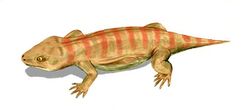Biology:Procolophon
| Procolophon | |
|---|---|

| |
| Procolophon pricei from the Early Triassic of South Africa | |
| Scientific classification | |
| Domain: | Eukaryota |
| Kingdom: | Animalia |
| Phylum: | Chordata |
| Class: | Reptilia |
| Clade: | †Parareptilia |
| Order: | †Procolophonomorpha |
| Family: | †Procolophonidae |
| Subfamily: | †Procolophoninae |
| Genus: | †Procolophon Owen 1876 |
| Type species | |
| Procolophon trigoniceps Owen 1876
| |
| Species | |
| |
Procolophon (from Greek: πρό pró, 'before' and Greek: κολοφών kolophṓn, 'summit')[1] is a genus of lizard-like procolophonid parareptiles that first appeared in the Early Triassic (Induan) of South Africa , Brazil , and Antarctica. It persisted through the Permian–Triassic extinction event, but went extinct in the beginning of the Early Middle Triassic. The type species is P. trigoniceps.[2]
History of discovery
The first Procolophon fossil was discovered in the 1870s in Donnybrook, an area southwest of Pietermaritzburg in present-day Kwa-Zulu Natal of South Africa . The fossil was accessioned to Harry Seeley, who described the fossil in 1878.[3] Numerous other fossils have been recovered since from localities across the Eastern Cape and Free State provinces of South Africa .[4][5][6][7]
Description
Procolophon reached a length up to 30 centimetres (12 in), and is considered to have been a small herbivore or insectivore. The skull of Procolophon is distinct because of its latero-posteriorly facing paired cheek spikes, along with spiked dermal ossicles. Paleontologists debate the function of the cheek spikes. Some paleontologists posit that the bony protrusions were points for muscle attachments. Procolophon also had large eyes, and may have had acute night vision. Its teeth were peg-like and suitable for crushing plant matter. The front of the skull was short and blunt with the nasal opening very close to the mouth.[8][9]
Classification
Procolophon is a basal member of Procolophonidae, a clade of parareptiles that are closely related to larger, more derived parareptiles such as the pareiasaur, Bradysaurus. Procolophonids are also related to mesosaurids and millerettids. Procolophon is also considered to share a sister-taxon relationship with Tichvinskia, a procolophonid from the lower Triassic of Russia .[10]
Correlation
Procolophon occupied a wide geographic range. Fossils of the genus were found in the Lystrosaurus Assemblage Zone of the Katberg and Normandien Formations of South Africa, to the Sanga do Cabral Formation of the Paraná Basin in eastern Brazil ,[11][12][13] to the Fremouw Formation of the Transantarctic Mountains.[14] Numerous subspecies and sister taxa are also found in the lower Triassic (Induan) of Germany , North America, and Russia .[15][16]
References
- ↑ Colbert, Edwin H. (Edwin Harris); Knight, Charles Robert (1951). The dinosaur book : the ruling reptiles and their relatives. New York: McGraw-Hill. p. 153. https://archive.org/details/bookruli00colb.
- ↑ Kemp, T. S. (1974). "The braincase and associated structures of the cotylosaur reptile Procolophon trigoniceps Owen". Annals of the South African Museum 64: 11–26.
- ↑ Seeley, H. G. (1 January 1878). "On new Species of Procolophon from the Cape Colony preserved in Dr. Grierson's Museum, Thornhill, Dumfriesshire; with some Remarks on the Affinities of the Genus". Quarterly Journal of the Geological Society 34 (1–4): 797–807. doi:10.1144/GSL.JGS.1878.034.01-04.51. https://zenodo.org/record/2455805.
- ↑ GOW, CE (1977). "Tooth function and succession in the Triassic reptile Procolophon trigoniceps". Palaeontology 20 (3): 695–704. INIST:PASCALGEODEBRGM7820073449.
- ↑ Carroll, Robert L.; Lindsay, William (1 November 1985). "Cranial anatomy of the primitive reptile Procolophon". Canadian Journal of Earth Sciences 22 (11): 1571–1587. doi:10.1139/e85-166. Bibcode: 1985CaJES..22.1571C.
- ↑ Groenewald, G.H. (24 September 1991). "Burrow casts from the Lystrosaurus-Procolophon Assemblage-zone, Karoo Sequence, South Africa". Koedoe 34 (1): 13–22. doi:10.4102/koedoe.v34i1.409.
- ↑ Cisneros, Juan Carlos (June 2008). "New basal procolophonid reptile from the Katberg formation (Lower Triassic) of the South African Karoo". Palaeoworld 17 (2): 126–134. doi:10.1016/j.palwor.2008.06.003.
- ↑ deBraga, Michael (1 April 2003). "The postcranial skeleton, phylogenetic position, and probable lifestyle of the Early Triassic reptile Procolophon trigoniceps". Canadian Journal of Earth Sciences 40 (4): 527–556. doi:10.1139/e02-082. Bibcode: 2003CaJES..40..527D.
- ↑ Cisneros, Juan Carlos; Ruta, Marcello (3 November 2010). "Morphological diversity and biogeography of procolophonids (Amniota: Parareptilia)". Journal of Systematic Palaeontology 8 (4): 607–625. doi:10.1080/14772019.2010.491986. Bibcode: 2010JSPal...8..607C.
- ↑ Ivakhnenko, M. F. (1973). "Skull structure in the Early Triassic procolophonian Tichvinskia vjatkensis". Paleontological Journal 7: 511–518.
- ↑ Dias-da-Silva, Sérgio; Modesto, Sean Patrick; Schultz, Cesar Leandro (1 November 2006). "New material of Procolophon (Parareptilia: Procolophonoidea) from the Lower Triassic of Brazil, with remarks on the ages of the Sanga do Cabral and Buena Vista formations of South America". Canadian Journal of Earth Sciences 43 (11): 1685–1693. doi:10.1139/e06-043. Bibcode: 2006CaJES..43.1685D.
- ↑ Cisneros, Juan Carlos; Schultz, Cesar Leandro (15 November 2002). "Procolophon brasiliensis n. sp., a new procolophonid reptile from the Lower Triassic of southern Brazil". Neues Jahrbuch für Geologie und Paläontologie - Monatshefte 2002 (11): 641–648. doi:10.1127/njgpm/2002/2002/641.
- ↑ Schoch, Rainer R. (1 February 2011). "A procolophonid-like tetrapod from the German Middle Triassic". Neues Jahrbuch für Geologie und Paläontologie - Abhandlungen 259 (2): 251–255. doi:10.1127/0077-7749/2011/0124.
- ↑ Kitching, J. W.; Collinson, J. W.; Elliot, D. H.; Colbert, E. H. (4 February 1972). "Lystrosaurus Zone (Triassic) Fauna from Antarctica". Science 175 (4021): 524–527. doi:10.1126/science.175.4021.524. PMID 17755654. Bibcode: 1972Sci...175..524K.
- ↑ Säilä, Laura K. (12 December 2008). "The osteology and affinities of Anomoiodon liliensterni , a procolophonid reptile from the Lower Triassic Bundsandstein of Germany". Journal of Vertebrate Paleontology 28 (4): 1199–1205. doi:10.1671/0272-4634-28.4.1199. Bibcode: 2008JVPal..28.1199S.
- ↑ Sues, Hans-Dieter; Olsen, Paul E.; Scott, Diane M.; Spencer, Patrick S. (27 June 2000). "Cranial osteology of Hypsognathus fenneri , a latest Triassic procolophonid reptile from the Newark Supergroup of eastern North America". Journal of Vertebrate Paleontology 20 (2): 275–284. doi:10.1671/0272-4634(2000)020[0275:COOHFA2.0.CO;2].
Wikidata ☰ Q146092 entry
 |


